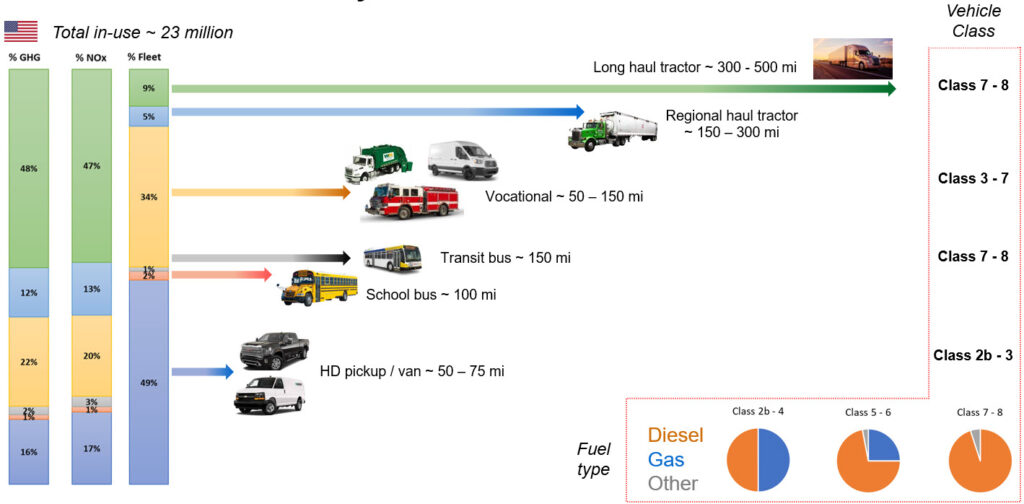On hydrogen requirements for long haul trucking in the US
Note for H2 lovers and critics – this is NOT a comprehensive review of the potential use of H2 for transportation. It is merely an attempt to put the H2 requirements into context, with some rather bold assumptions.
Summary
To convert 25% of the long-haul truck* fleet in the US to hydrogen fuel cell will require:
- Doubling of the total H2 demand in the US today
- Doubling of the renewable electricity generation today (for green H2)
- A very small increase in the water usage
*Assumed to cover ~ 350 miles per truck per day
H2 for long-haul
In a previous post, we have examined the current make-up of the heavy-duty fleet in the US according to vehicle class, range and end applications. The key figure is included here. It is worth highlighting again that long-haul tractors make up < 10% of the fleet but emit almost half of the greenhouse gas and NOx emissions. This class is seen as especially suited for H2 fuel cell and H2 combustion, to address long range requirements and rapid “refueling”.


How much hydrogen is required to power fuel cell trucks?
There are far fewer fuel cell truck offerings on the market compared to battery electrics to adequately address this question. Still, here is what we have so far – see chart for some of the current offerings of hydrogen fuel cell trucks for freight transport. One of the key technology differentiators is the on-board hydrogen storage [1] :
- Compressed gas at 350 bar as currently offered on the Hyundai Xcient
- Compressed gas at 700 bar, likely on the Nikola TRE
- Liquid H2 as demonstrated by Mercedes-Benz
- Cryo-compressed H2 – a hybrid technology including compression at 300 bar followed by storage at -150 to -240 C. Not ready for prime time yet.
The advantage of compressing to higher pressures or liquefaction is clear – the higher volumetric densities allow for increased fuel capacity and reduced refilling times.
From the limited data available now, it is seen that the trucks consume ~ 14.4 kg-H2 per 100 miles.
NOTE : H2 densities listed here are total technology system storage density and not pure gas densities.
Calculations for 25% of the fleet to run on fuel cells
Assume that 25% of the long-haul fleet of ~ 2 million trucks is eventually (2040? the time doesn’t matter here) converted to hydrogen fuel cell. That’s 500,000 vehicles running on H2. Further, assume a daily driving distance of 350 mi.
So, H2 annual requirement = 500,000 x 350mi/day x 365 day/yr x 0.144 kg-H2/mi = ~ 9.2M tons
To put that in context, note that the US total H2 demand today is ~ 10M tons per year [2], almost all derived from steam reforming of natural gas. So to support 25% share of fuel cell trucks of the long-haul fleet will require doubling of the H2 production – using renewable electricity (green H2) or at least via natural gas but combined with carbon capture (blue H2).
Electricity required
So assuming we do go the green route and make H2 via electrolysis using renewable energy. It takes ~ 50 kWh to produce 1 kg of H2 [3].
So overall H2 production would require 50 kWh/kg x 9,200M kg = 460 TWh of electricity.
Again, to put this into perspective, the total US electricity generation in 2021 was 3,900 TWh of which ~ 12%, or 468 TWh was renewable (hydro, wind, solar, biomass, etc.) [4]
So to support the above 25% fleet conversion to fuel cells would require a doubling of the renewable electricity generation (just for H2 production).
Water required
Finally, let’s not forget about water, the source of H2 using electrolysis. It takes at least 9 kg of water (~ 2.4 gal) to make one kg of H2.
So it would take 9 x 9.2M tons = 83M tons (or 200M gal) of water annually.
That is a very small fraction of the > 300B (billion) gal of water used in the US per day.
References
[1] International Council on Clean Transportation (ICCT): FUEL CELL ELECTRIC TRACTOR-TRAILERS: TECHNOLOGY OVERVIEW AND FUEL ECONOMY
[2] NREL
[3] Paul Martin “Distilled Thoughts on Hydrogen“
[4] US EIA
If you like such content, check out the monthly newsletter covering the latest on sustainable transportation technologies and regulations. Sign up below.
Like it ? Share it !
Other recent posts
Conference Summary – SAE WCX 2025
![]()
A summary of the “SAE WCX 2025” conference held in Detroit.
IRENA Renewable Energy Capacity Statistics 2025
![]()
According to the latest report from IRENA, 2024 saw the largest increase in renewable capacity, accounting for 92.5% of overall power additions.
CO2 Emissions Performance of Heavy-Duty Vehicles in Europe – 2022 Results
![]()
The European Commission has published the official 2022 CO2 emission results for heavy-duty vehicles. Many OEMs are ahead of the targets and have gained credits, while others have their work cut out as we approach the 2025 target.

